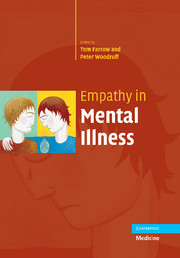Book contents
- Frontmatter
- Contents
- Foreword
- List of contributors
- Part I ‘Dysempathy’ in psychiatric samples
- 1 Empathic dysfunction in psychopathic individuals
- 2 Empathy deficits in schizophrenia
- 3 Empathy, antisocial behaviour and personality pathology
- 4 Empathy and depression: the moral system on overdrive
- 5 Empathy, social intelligence and aggression in adolescent boys and girls
- 6 Impaired empathy following ventromedial prefrontal brain damage
- 7 Non-autism childhood empathy disorders
- 8 Empathy and autism
- Part II Empathy and related concepts in health
- Part III Empathy models, regulation and measurement of empathy
- Index
8 - Empathy and autism
from Part I - ‘Dysempathy’ in psychiatric samples
Published online by Cambridge University Press: 17 August 2009
- Frontmatter
- Contents
- Foreword
- List of contributors
- Part I ‘Dysempathy’ in psychiatric samples
- 1 Empathic dysfunction in psychopathic individuals
- 2 Empathy deficits in schizophrenia
- 3 Empathy, antisocial behaviour and personality pathology
- 4 Empathy and depression: the moral system on overdrive
- 5 Empathy, social intelligence and aggression in adolescent boys and girls
- 6 Impaired empathy following ventromedial prefrontal brain damage
- 7 Non-autism childhood empathy disorders
- 8 Empathy and autism
- Part II Empathy and related concepts in health
- Part III Empathy models, regulation and measurement of empathy
- Index
Summary
Introduction
For anyone who needs to be persuaded of the critical role that empathy plays in human interpersonal engagement, or who wants to learn more about the significance of empathy for early human development – or even, perhaps, one who seeks to understand what empathy is – there could be few sources of insight more arresting than the phenomenon of early childhood autism. From a complementary perspective, I would contend (against considerable opposition from my fellow researchers in the field) that it is only when one grasps the far-reaching developmental implications of the lack of empathy experienced by children with autism, implications that are serious for cognitive as well as social development, that the pathogenesis of this condition becomes understandable.
These claims exemplify the perspective of developmental psychopathology that I shall be adopting for this chapter. The specialness of the approach is that it involves the coordinated study of typical and atypical development. This allows one to apprehend otherwise obscure processes and mechanisms of typical development on the one hand, and specific forms of derailment in development leading to psychopathology on the other. Just as the study of autism reveals a great deal about empathy, so an appreciation of the developmental role of empathy in typical development promises to deepen our understanding of the pathogenesis of autism.
- Type
- Chapter
- Information
- Empathy in Mental Illness , pp. 126 - 142Publisher: Cambridge University PressPrint publication year: 2007
- 7
- Cited by

